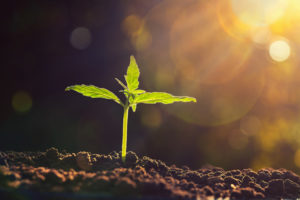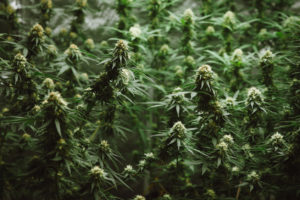My November blog – Successful Indoor Hemp Growing – touched briefly on plant nutrition. It’s a big topic that deserves a bit more focus, so this month, let’s go in-depth on how to get the right nutrients to your hemp plants as they grow to maturity. The first thing we need to understand is that what the hemp plant needs at various stages of growth changes over the course of its development. In other words, what a seedling requires is different from what a flowering plant requires. Let’s break down our conversation by life stage.

SEEDLINGS
Nutritional requirements are strongly connected to the growing medium. If you are growing seeds hydroponically indoors, every nutrient the plant needs must be added to the growing medium: water. Conversely, if you field-plant your seeds directly into the soil, you will need soil analysis to understand what may or may not be lacking nutritionally in that growing medium and then add nutrients accordingly. Starting seeds indoors in sterilized, peat-free potting compost or soil-less coco coir/perlite mixtures is yet another common scenario and it has yet another set of nutritional requirements.
Regardless of how you start your seedlings, you want to support them with nutrients that – along with proper light, humidity, watering, temperature, and pest control – will assure robust, resilient, CBD-rich plants with optimal yields. And what those little seeds need nutritionally doesn’t vary no matter what medium they grow in. Our job as growers is to know and deliver any needed nutrients missing from the growing medium.
Germinating seeds need little more than water to get going. Once they send out their first three or four leaves, you’ll want to slowly introduce a 3-3-3 nutrient solution containing equal parts nitrogen (N), phosphorous (P), and potassium (K). Overfeeding can shock the tiny plants, so go easy until they are more established.

VEGETATIVE PHASE
Building a strong plant structure happens during the vegetative phase. This is when we’re encouraging nice sturdy stems and petioles that can later support flowers and withstand the elements. The vegetative stage begins when the plant sends out a complete set of leaflets. The hemp is focusing energy on growth and strength both above and below the soil level. Indoors, this stage lasts four to eight weeks, depending on how big you want to grow the plant. Outdoors, this stage can continue for 16 weeks or more.
Nutritionally speaking, plants in the vegetative phase will start to need more nitrogen, and proportionally less phosphorus and potassium. Nitrogen is required to build amino acids and proteins necessary for a strong structure. NPK are macronutrients – the most important building blocks for plant quality. Secondarily, magnesium, calcium, and sulfur should be added at this stage, as well as minimal concentrations of micronutrients: zinc, manganese, iron, boron, chlorine, cobalt, copper, molybdenum and silicon. My best advice for achieving the correct balance and frequency for your specific situation is to follow manufacturers’ directions on the product packaging. It’s also better to under fertilize than overfertilize; you can coax along an under-fertilized plant more easily than you fix problems in an over-fertilized plant.

FLOWERING PHASE
As hemp moves into and through the flowering phase, we ease off on N, relative to P and K. The calcium and magnesium will encourage your plants to send out a vigorous root system and continue building a hardy plant structure above the soil. At the latter end of the flowering phase, N should drop to about two-thirds the level of P and K. As you watch your plants develop through the flowering phase, you’ll see preflowers form, then the plant will transfer energy from growth to bud development. Some growers like to up the P levels a bit to encourage blooming and bigger flowers.

A WORD ABOUT Ph LEVELS
All the nutrients in the world will not help your plants thrive if the soil pH levels are not right. For CBD hemp, you want to aim for a pH level between 6.0 and 6.5, although 5.5 to 7.0 is considered the acceptable range – neither too acidic nor alkaline. If you are growing your plants hydroponically, they tend to do best at the lower, more acidic end of the scale: around 5.6 to 5.8.
Why do we care about pH levels? Because it is vital to correctly functioning biochemical pathways that transport nutrients from the soil or the air to the plant itself. In other words, soil that is too acidic or alkaline will prevent needed nutrition from getting to your plants and they can starve and struggle. So, yeah, pretty big deal, right? There are growers who consistently monitor the pH levels of their medium for precisely this reason, so that if the balance begins to tip one way or the other, they can course-correct with pH Up or pH Down additives.
KEEPING THE SCIENCE SIMPLE FOR THE BEGINNER
If all this feels like mastering a huge chemistry lesson …. well, you’re not wrong. There’s a fair amount of science to learn for any hemp farmer. The good news is, it gets easier and more intuitive with experience. Getting through a first full grow cycle with hemp will teach you a lot. For the novice, it can be more beneficial to focus on the macronutrients and some calcium and magnesium as they approach flowering. Ask your grow store expert, local extension service, and fellow growers for insights that have been proven to work in your local area. As you become more adept at “reading” your plants and more knowledgeable about plant performance in your region, you can start supplementing and experimenting successfully with additional micronutrients. Also note that you are less likely to over-feed when you use natural versus chemical fertilizer.
ONLINE WISDOM
As a final note, the internet is – of course – full of educational resources and tutorials for the hemp grower. It’s a great place to go for answers. For example, when leaves are starting to turn a funny color, seeing visual examples online coupled with some diagnostic information can quickly give you the right clues you need to adjust your feeding regimen and get your plants back to good health. You’re also welcome to send your questions to us. Reed and I have decades of growing experience all over North America and the world and would be happy to steer you in the right direction on nutrient and other hemp-cultivation questions. You’ll find our contact form here.


Recent Comments